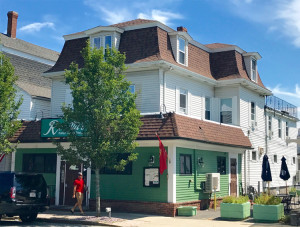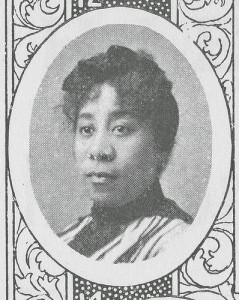True Tales Revisited: Mrs. Brown’s Hotel
By George T. ComeauThis story was originally published on August 24, 2017 and was reprinted in the most recent edition of the Canton Citizen.
In the 1870s, Mrs. Brown’s House was the center of the celebrity world in Canton. With a handsome mansard roof situated along a beautiful street lined with ancient elm trees, this was Canton’s grand hotel. Anyone coming to stay in Canton would find a room at Mrs. Brown’s, and now we know the guest list was impressive.
For many years local historians only knew that there was once a hotel at 521 Washington Street. The backstory and history is only now coming to light, and that is thanks to a descendant of Mrs. Brown who has discovered some wonderful treasures in the family attic. On a recent Sunday afternoon, a family member brought what appeared to be an old scrapbook to the Historical Society. Nothing was known of the cryptic marks and signatures. A closer inspection and some historical sleuthing opened a window that had been closed for close to 150 years.
In the mid 1850s, James and Abigail Meserve came to Canton from Sweden, Maine. What brought them to Canton may well have been the building boom that was underway as a result of the expansion of the railroad and the factories that had burgeoned along Washington Street. Born in 1796, James Meserve was an accomplished housewright, and at some point he met Orin Brown, a 34-year-old fellow carpenter from Berwick, Maine. In 1866, Orin married James’ daughter Roseanna, and the two families were brought together. Two years later, in 1868, Orin and his father-in-law purchased a handful of buildings along Washington Street. In all likelihood the property transactions were done for Abigail, as she figures prominently in the deeds through time.
Orin and Roseanna lived in Hyde Park for a time, and they had two children. By 1869 their daughter was born in Canton and Orin apparently moved back to Hyde Park. Roseanna continued to live in Canton with her mother, Abigail. In fact, the mortgage for the buildings on Washington Street was paid off within 11 months, and additional properties were purchased by Abigail Meserve both in Canton on Rockland Street and in Hyde Park.
From the start, the purchase on Washington Street was intended as a boarding house and hotel. The property right next door (and perhaps owned by Brown & Meserve) was a boarding house, and records show that a portion of the property was being managed by a widow by the name of Emily Tirrell. Living in that boarding house were Tirrell’s 17-year-old daughter and a married son and his wife, and their infant child, along with 12 boarders and two Irish servants. Aside from the boarders, a dental surgeon would take up some rooms every Wednesday to ply his trade in the unsanitary environment.
And right next door lived Abigail Meserve and Roseanna Brown. It would appear that all the property was at that time owned by Abigail, and certainly by the time she died in 1881 her will clearly indicated that she owned the hotel and several properties as part of her estate.
As the pages turned in the old ledger, dates and names were revealed. These were the guests of the hotel — each signature with a story to tell. With some research, it was revealed that the guests included family and friends of Mrs. Brown as well as salesmen and merchants conducting business with the captains of Canton’s industry. Far more impressive, however, are the dozens of performers who stayed at the hotel each month while on tour and performing at both of the venues in town. There seems to have been far more live entertainment in late 19th century Canton than there could ever be today.
Perhaps the most wonderful thing to know is how many of the performers that came to Canton and stayed at the Brown Hotel were African American. Most notably was a performance by the Hopkins Colored Troubadours. On April 2, 1881, the hotel registered 16 guests, many of them black performers, and most notably among them was Pauline Hopkins.
Pauline Hopkins, born in Portland, Maine in 1859, grew up and lived her entire professional life in Boston. Hopkins was a theatrical superstar. Dubbed “Boston’s Favorite Colored Soprano,” she toured with her family’s ensemble troupe, the Hopkins Colored Troubadours. They were a sensation wherever they traveled and Pauline wrote many of the musical numbers. She was an early pioneer, tackling the messaging of the weighty problems of social reform, emancipation, and the economic opportunities facing African Americans. At age 22 she walked from the train in Canton Junction alongside her mother and father (a Civil War veteran) and performed at Memorial Hall to benefit the Grand Army of the Republic, the local Civil War veterans group. It is likely that they performed Flight to Freedom written by Pauline and originally titled Slaves’ Escape. It is easy to sense that Canton in the 1880s was a welcoming and tolerant town when issues of race and equality were sensitive topics of the day.
That same hotel register marked the arrival in September 1881 of a very large performance of Uncle Tom’s Cabin under the production banner of C.H. Smith. In vogue at the time were dozens of “Uncle Tom” shows that toured throughout New England. With a cast of more than 22 actors, and a few dogs and a pair of donkeys, the spectacle was a sight to behold. They performed at Brook’s Opera House at the corner of Bolivar and Washington streets to a packed crowd. The New York Times reviewed the show when it arrived the following spring and observed, “This mammoth version of ‘Uncle Tom’s Cabin’ is without exception the most absurd attempt at the dramatizing of Mrs. Stowe’s novel that was ever made. Uncle Tom and all the strong characters of the work are kept studiously in the background, and the leading parts are assumed by the alleged bloodhounds, who rush on and off the stage yelping and barking continuously, and two donkeys, which are introduced for no apparent purpose but to add to the menagerie on exhibition. There are two Topsys, both of whom managed to bore instead of amuse the audience with their stupid antics, and two lawyers, a Marks, Sr., and a Marks, Jr., who are intended to be funny, but who are in reality very dreary, of the human portion of this remarkable ‘mammoth’ drama charity dictates that nothing be said.”
But perhaps the most dramatic and over the top guests that stayed at Mrs. Brown’s was the “Paste Brigade No. 1,” sent in advance of the John H. Murray New Show, Circus, Menagerie, Museum and Aquarium. The paste brigade was in charge of placing posters all across town to build excitement and anticipation for the spectacle that was about to arrive. And arrive they did. It took 23 railroad cars into Canton Junction to support the show. Twelve trained Lilliputian ponies led a “grand free street procession at 10:00 am on the appointed day.” Incredibly, more than 100 principal performers came to town, along with 25 cages of animals, a full-fledged museum filled with “new and startling curiosities,” and an aquarium filled with “rare and beautiful specimens of the Finny Tribe.”
The paste brigade arrived in Canton on May 7, and the circus arrived on the morning of May 18. The local paper covered the event: “It is frequently remarked when a circus comes to town that it will make the town poorer, but the visit of Murray’s show made Canton richer. The weather was so severe Wednesday, that they gave no performances.” Fortunately, they paid for all their rooms at Mrs. Brown’s Hotel.
Short URL: https://www.thecantoncitizen.com/?p=36961












